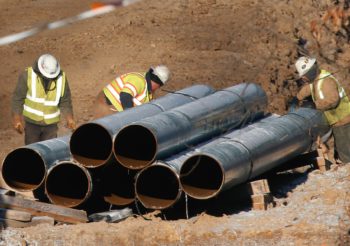 Oil and gas prices have soared since Joe Biden took office and skyrocketed further as Russian troops surround Ukraine. Prices will get worse — much worse — if Putin invades.
Oil and gas prices have soared since Joe Biden took office and skyrocketed further as Russian troops surround Ukraine. Prices will get worse — much worse — if Putin invades.
President Biden has promised, “swift, sharp sanctions” on Russia and an end to the Nord Stream II pipeline, which will supply Germany with much-needed Russian natural gas when it’s completed.
The German chancellor has said little about ending the pipeline but has not publicly contradicted Biden’s threat to stop it.
European analysts are confident Germany will go along with American energy sanctions, including those on Nord Stream II.
In any case, the US can stop the pipeline, if it chooses. It has the financial tools to prevent the pipeline from going into service and, more broadly, to sharply curtail Russian energy sales to the West.
If the US and its NATO partners apply those sanctions, they would leave a huge shortfall in European energy supplies and a smaller one in the US, which now relies on some Russian imports themselves.
Russia currently supplies about 10 percent of the world’s energy and dominates Europe’s natural gas supplies, which are essential for home heating and power generation.
The economic questions are obvious: who will fill the supply gap? How long will it take? What will happen to prices in the short- and medium-term? Will surging prices cause a major slowdown in Western economies?
The political question for Joe Biden is simple and painful: will an energy crunch force the administration to change its pro-green policies, which have curtailed supplies?
Those policies have already meant higher costs for consumers to fill up their cars and heat their homes. Those mischievous stickers on gas pumps, showing Joe Biden pointing at the price-per-gallon and saying “I did that,” are cruel but correct.
Sanctions on Russia would raise those prices even higher. Moreover, the increases would come on top of surging inflation and slumping real wages, posing more political problems for an administration that already has too many of them.
Consumers — better known to politicians as voters — already blame Biden for inflation, which has reached a four-decade high and is running well ahead of wage gains.
They’re troubled, deeply troubled. Polls show only 30 percent of voters think the country is headed in the right direction, a devastating number for any incumbent. (Who, pray tell, are the 30 percent who think things are going well?)
Pain at the pump is part of that story, and that begins with the administration’s constraints on energy production. Those began with a flourish on Inauguration Day, when Biden canceled the Keystone XL pipeline from Canada.
He’s shown no signs of stopping, even though gas prices are up over $1 per gallon in the past twelve months and up 20 cents in the last month alone.
Among the Biden administration’s latest mistakes on that front is a needless blow to Europe’s effort to diversify its energy sources.
In mid-January, the administration quietly killed a mammoth, multi-year pipeline project to supply Europe with gas from a huge Israeli offshore discovery.
The EastMed pipeline, a joint effort of Israel, Greece, and Cyprus, was backed by Bulgaria, Hungary, North Macedonia, Romania, and Serbia. The Trump administration was a strong advocate, consistent with its overall support for the Jewish state and for energy exploration.
The lone opponent was Turkey, which demanded all gas to Europe go through Turkey. The Biden administration reversed Trump’s policy and caved to Turkey.
They did so quietly, with an “off-the-record” State Department paper and, according to reports, without consulting Israel, Greece, or Cyprus.
Bad as that decision looked in mid-January, it looks far worse now that Putin is threatening Ukraine and, consequently, Europe’s energy supplies.
The policies on Keystone XL and EastMed are consistent with Biden’s overall approach: limit oil and gas production, refining, and distribution.
Reverse Trump’s pro-drilling policies. Fund alternative, renewable fuels. The immediate goal is to sharply lower carbon emissions. The medium-term goal is zero emissions.
In areas where Biden has the most control, such as publicly owned lands, offshore drilling, interstate pipelines, and federal regulations, he has acted most aggressively. It is those stringent policies that would face intense political pressure if oil prices rise still further.
Biden’s opposition to fossil fuels has broad support within the Democratic Party. That support remains strong despite rising prices. But Independents are clearly unhappy.
Since they are upset with so many Biden policies, it’s hard to disentangle what troubles them most. Still, it is striking how little this rising resentment and declining popularity has affected Biden’s policies. Zero, zip, nada.
The president and his team have hardly budged, not only on energy but on “Build Back Better” and other policies.
That rigidity would be severely challenged by much higher energy prices. Of course, Independents would be aggravated. More interesting politically is what happens within Biden’s own party.
Higher energy prices and public outrage would drive a wedge among Democrats, separating the most determined green energy partisans — those who think climate change is the most dangerous, immediate crisis facing the planet — from more centrist Democrats, who certainly favor big reductions in carbon emissions but don’t want to lose the next two elections to get there.
Biden would be caught between these opposing factions if Russia invades Ukraine and energy prices spike. He can take some small, easy actions, of course, without raising hackles. …snip…
The real question is whether, faced with a shortfall in energy supplies and rising prices, Biden will alter his long-term effort to restrict oil and gas drilling and distribution.
Read rest at Spectator World


















Build Back Better just another meaningless campaign slogans like Hope and Change since we did,nt get either and beside the Bitter Biter Bittern make far better toungue twister like Betty’s Bitter Batter